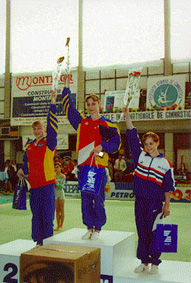Welcome
 At romaniangymnastics.ro, it is our mission to bring to you in an easy to understand, concise, and most importantly, fun, way the history and future of Romanian gymnastics.
At romaniangymnastics.ro, it is our mission to bring to you in an easy to understand, concise, and most importantly, fun, way the history and future of Romanian gymnastics.
We aim to promote this highly competitive, and thus highly engaging, sport by giving in-depth information regarding current events and how they factor into the overall prospect of gymnastics in the country.
Our mission involves providing a platform to promote the sport, to make its inner mechanics available for the common people so that they do not see this activity as something hard to achieve and aspire for, but rather a sport their sons and daughter could excel in if they but have the aptitude for it.
Why gymnastics?
Why indeed. When watching gymnasts perform on TV or live, it is only natural to marvel at their inhuman routines and acts. From one end of the floor to the other, or across the bars and ramps, they make the spinning and jumping and cartwheeling look so appealing and easy, even though the audiences know deep down that it is not so.
And, at the end of it all, to finish the set by landing square of their feet, without a shake, seems, without doubt, an impossible feat. The hard thump of bare soles on board is enough to set a-tremble any juggernaut's bones.
The raw power and strength of the performances, the flexibility, grace, balance overall, the sheer impossibility of the maneuvers take years to learn. Romanian Women's Gymnastics team member, the legend Larisa Iordache, started learning when she was only four and a half years of age. It takes the supple, lithe and pliable body of a child to bear the strains of rigorous training and pay the hard prices that need to be paid when one seeks the ultimate in anything. Young bodies are malleable enough to accept the molding.
Though it is true most of us cannot claim to have a fresh enough physique to qualify for competitive gymnastics, that does not mean training is useless. Gymnastic routines and forms are good for everyone if only you can develop the patience to bear through. How can gymnastics be good for you or your children? Take a look:
- Flexibility - No sport is as flexible, or as demanding for the character, as gymnastics. This is pretty obvious from watching professionals perform but learning and practicing the sport can help children and adults in other spheres of life as well.
For the most part, many injuries can be avoided if a person is able to bend their body beyond the rigid form it was born in. Our bodies were not meant always to sit straight, or always to be held in such a way as to give the impression of a stick up the backside. The purpose of joints is activity and movability and failing to put it through the motions as often as possible makes them go unyielding and stiff, which is prerequisite for the onset of premature joint pains.
Apart from avoiding pains, being flexible can help you evade something as small as stubbing a toe, and as large as tearing a hamstring while on your morning jog. The motions also put into use other parts of your body you don't usually use like you butt muscles and your calves. The routines require a lot of energy, which burns fat and keeps your body lithe and strong. A slim and sturdy body is important for being flexible, but to lose weight in the first place is an added bonus. - Improved self-esteem and confidence - A study conducted at the Robert Wood Johnson Medical School found that students participating in regular physical activities have better self-esteem and self-reliance. This boils down to being comfortable in your body and your skin, in not being worried about your form, and in having the confidence to perform before a large group of peers, which happens in school PE classes.
Teaching gymnastics in schools is encouraged because it allows the children to learn through progression, to get better at something through regular practice and be able to see the benefits in a short time. With each improved performance, they get more confident in themselves, and this confidence carries to other aspects of their lives. - Improved cognitive functions - Advantages of physical activities like gymnastics and other rigorous sports are not limited to bodily gains only. They also benefit a person's concentration and mental focus, which in turn allows them to improve cognitive functions.
Gymnastics is not learned by reading a book or taking notes - not entirely, at least - but by watching and paying attention to others perform and then having the confidence to perform on your own. This watching requires the children to focus their concentration and be diligent, in case they miss something. - Discipline - As is often stressed in the army and other situations where people work in a team under the leadership, discipline is what keeps you safe and ensures the completion of a mission. To be able to stick to a plan is a skill most gymnasts learn early since it is easy to notice that constant practice and corrections garner great results quickly. Gymnasts often have to perform acts on their own, without supervision, as the coach might be busy with other people, and they learn to be self-reliant and follow instructions to the letter, in order to avoid serious injury to self and others. This takes discipline.
- Social skills - This is an unusual side effect, though very beneficial. Watching others perform at a very young age and seeing that they are better than you, teaches you to respect your older peers and to learn from their examples. Alternatively, older students learn to be an idol and an example, knowing that their actions are being noted by the youngsters and you influence them. They develop into reliable role models that the younger children can look up to and later emulate.
Gymnastics Teams
Women
 As with many of the great gymnasts, Larisa Iordache was very young when she first started training, being only 4 and a half years old. By the time she was 12 years of age Iordache had earned a place in the national junior team and was set to become well-known in the competitive artistic gymnastics world. It was not long before the Press was dubbing Iordache "the new Nadia" (in reference to Nadia Comaneci) based on the potential that was seen in her to become one of the greatest gymnasts to come out of Romania.
As with many of the great gymnasts, Larisa Iordache was very young when she first started training, being only 4 and a half years old. By the time she was 12 years of age Iordache had earned a place in the national junior team and was set to become well-known in the competitive artistic gymnastics world. It was not long before the Press was dubbing Iordache "the new Nadia" (in reference to Nadia Comaneci) based on the potential that was seen in her to become one of the greatest gymnasts to come out of Romania.
Iordache burst onto the international competitive gymnastic circuit in 2010 when she attended her first major international event the European Championships hosted by Birmingham, United Kingdom. She competed in individual events, as well as part of the Romanian gymnastics team which places second behind Russia. As an individual Iordache placed third in the all-around final, as well as winning the fourth place on vault, a second place on balance, and tied for first place with her floor routine.
Men
Dragulescu first appeared on the international competition circuit in 1988, competing as a junior in the European Championships hosted in St. Petersburg. By the end of the competition Dragulescu was the proud winner of a gold medal for his performance on the pommel horse, a silver medal for vault, and a bronze medal for his floor performance and as part of a team. He took 8th place in the individual all-around competition.
Dragulescu's international debut as a senior gymnast came in 1999 when he represented Romania at the World Championships hosted by Tianjin, China. Despite putting forth his best effort Dragulescu's results were less than hoped, being placed fourth on vault, eighth on the high bar and a mere 26th all around.


